What makes a great pie? I’ve been pondering this question recently with apple season upon us.

Bushels of Champlain Orchard apples, headed for market
I’ve come to realize a few things:
1. Pie crust recipes are universally the same (I’m stretching the truth a little, but not by a lot – they all follow standard ratios of flour to butter to water, plus a little salt and sugar).
2. How people choose to execute pie crusts varies and accounts for most of the success and failure people have with pie crust.
3. The filling is a matter of personal preference – you may like firm pieces of fruit or soft, a thick and gooey filling or a juicy one, a sweet filling or a tart one, etc. Don't believe anyone but yourself when it comes to how to make the filling.
With these ideas in mind, I observed the apple pie class we recently hosted.
It was really interesting, because our instructor, Jane, who had just started working at Champlain Orchards, was in the process of figuring out how her own techniques for pie baking fit with the demands of baking hundreds of pies a day.
She likes whole wheat pastry flour in the crust (you can see the brown flecks in the dough below). She doesn't mind if the dough gets warm before she rolls it out - it's forgiving, she says. She can tell by feel if there's enough water in the dough, enough to roll it out into a nice, smooth circle that's one inch wider than the widest part of the pie pan:
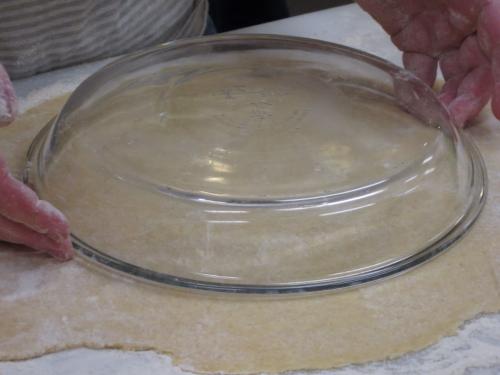
She heaps the pan with apples. I mean HEAPS. The apples are cut nice and thick so they retain a firm texture, with loads of cinnamon and nutmeg. She favors Cortland apples:
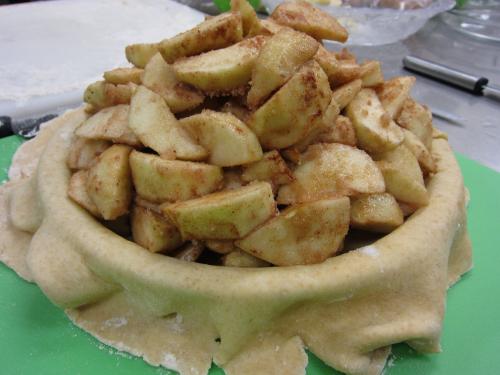
The second crust is draped over the heaped filling:
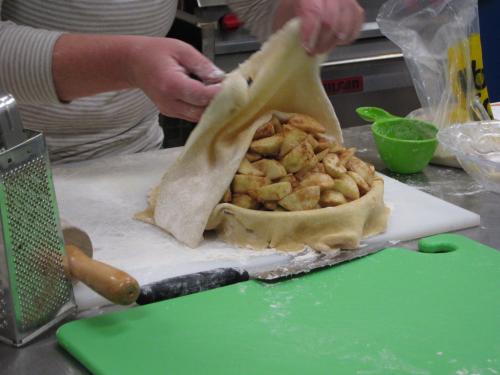
She trims some of the overhanging dough and tucks the edges under all the way around:
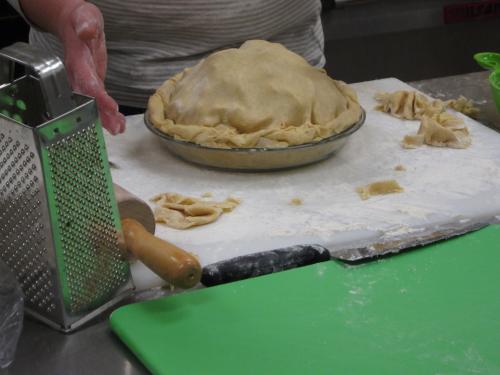
Then she pinches the edges to make that nice crimped or "fluted" shape:
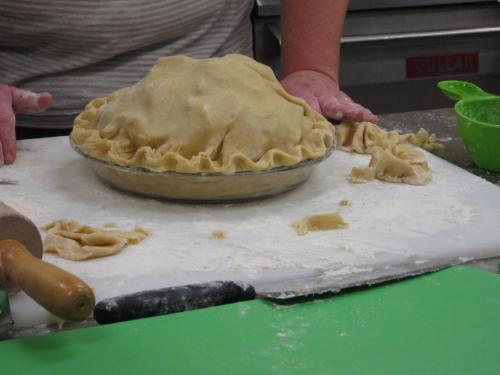
A few vents in the top, a sprinkle of sugar, and a nice bake in the oven - Voila!
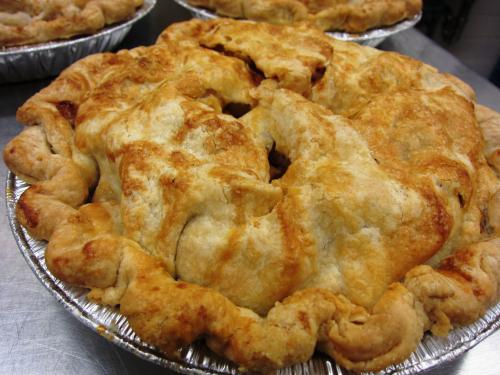
When I thought about this post, I thought I might impart some pie making wisdom, but it really comes down to developing a feel for the dough, a confidence in the process, and a decision about YOUR taste preferences for the filling. Which means more practice. Which means more pie. :-)
Happy baking.
Pie Crust
You can mix pie dough by hand or with a pulsing action of the food processor – both to cut in the butter and incorporate the water. Be sure not to overmix; light handling is the key to a flaky crust! For a single crust pie, cut this recipe in half, or save half of the dry mix before adding water for another time. Wrap and refrigerate for up to 1 week or freeze for a month or more.
Dough for 2 10-inch crusts:
1 cup unbleached white flour
1 cup whole wheat pastry flour
Dash of salt
2/3 cup butter, chilled
5-6 Tbs. of ice water
Stir the flours and salt together in a mixing bowl. Cut in the butter using a pastry blender or two knives. A food processor will do this beautifully! Continue working the dough (use fingers if you like), just until butter is broken into small pieces the size of a pea.
Mix in the water, a tablespoon at a time, until the dough holds together but is not sticky.
Dive the dough into two balls, wrap in plastic wrap, and refrigerate for at least 30 minutes. If you’re pressed for time, put in freezer for 10 minutes.
On a floured surface, roll one dough ball into a circle that’s about 2 inches bigger around than your pie plate – enough for the sides of the pan plus a 1-inch overhang. Hold the plate over the dough to check the size. Gently fit the dough into the pie pan.
For a single crust pie, fold the extra dough under so that it is even with the lip of the pan. Using the thumb and index finger of one hand and the index finger of the other, push the dough in while you pinch the edges into a fluted pattern all around the pan.
For a double-crust pie, let the edge of the bottom crust hang over the edge of the pan. Spoon in the filling. Roll the 2nd dough ball into a circle that’s about 1 inch bigger around than your pie plate. Center it on top of the filling. Trim the edges of the top and bottom crust so they are even. Press them together, fold them under, and flute. Use a sharp knife to cut a few slits into the trop so that steam can escape.
from Beyond the Moon Cookbook
Pie Filling
8 cups peeled apples, such as Cortland
3/4 cups sugar
3 Tbs. flour
1 tsp. cinnamon
1/2 tsp. nutmeg
Fill empty pie shell with filling, top with crust, trim edges to 1 inch overhang and tuck under. Flute and cut 3-4 vents in top crust. Bake in 350 degree oven for 40 minutes, turning once.
from Champlain Orchards






